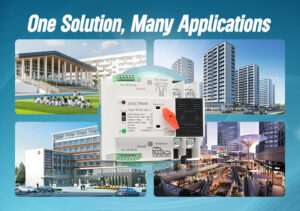Power outages hurt production, break equipment, and put people’s safety at risk, which costs businesses and homes a lot of time and money.
An automatic transfer switch (ATS) is an electrical device that automatically switches loads to a backup power source when the main source fails. This makes sure that electricity stays on without any problems.
It’s not enough to just know that ATS stops blackouts; you also need to know how it works, why you need it, and how to choose the proper type for your building. This article will help you make a sensible choice by going over functionalities, how they work, how to install them, illustrations, and cost-effectiveness.
Why Do I Need an Automatic Transfer Switch?

Power outages can happen at any time, which can be stressful, cause data loss, and damage equipment if there is no backup mechanism in place.
An ATS is important for anyone who needs power all the time, especially in areas where the grid goes down often, because it automatically turns on and switches to backup power without any help.
When you compare ATS to manual transfer switches, you can see how useful it is. Manual models are less expensive, but they can’t ensure protection from abrupt outages. In important fields like healthcare or IT, even a small interruption can be very bad, hence ATS is a must, not a nice-to-have.
How Does the Automatic Transfer Switch Work?
Your equipment can’t wait for judgments that are late or mistakes made by people when the power goes off.
An ATS keeps an eye on voltage and frequency all the time. If there is a problem, it automatically switches to the utility source and then to a generator or backup source. When the main grid stabilizes, it automatically restores electricity.
Most ATS systems have a control logic unit that works as the “brain” and carries out source monitoring, delay timers, and switching commands. The transfer may generate a small pause or no visible blink at all, depending on the style of transition: open (break-before-make) or closed (make-before-break).
Automatic Transfer Switch Installation
If you don’t install ATS correctly, it can make things less safe and not do what it’s supposed to do.
Most of the time, ATS units are situated near the main electrical panel. They have separate terminals for utility input, generator input, and load output, which makes sure that electricity is distributed safely and efficiently.
During installation, personnel need to make sure that the breakers are off, the wiring is color-matched, and the connections are tight. Wiring the phase and neutral lines from the breakers to the ATS inputs and then back to the distribution box breakers from the ATS outputs are common steps. It’s very important to have the right grounding and follow electrical rules. Always hire licensed professionals to make sure everything is safe and works right.
Automatic Transfer Switch Diagram
Visual clarity makes complicated systems easier to understand and cuts down on mistakes during installation.
A basic ATS diagram has three terminal groups: utility supply, generator supply, and load output. It also has controls for auto and manual operation and source indications.
Diagrams are very important for both installers and operators because they help them understand how electricity flows and make transitions more predictable.
Is a Transfer Switch Worth It?
In the long term, cutting corners on electricity reliability frequently costs more.
A transfer switch is worth the money since it protects against downtime, damage to equipment, and loss of data. It also makes sure that both home and industrial uses are safe and legal.
Manual transfer switches may be cheaper to buy, but they can’t guarantee that they will work. On the other hand, automatic solutions let you work without using your hands and protect important loads during power outages. ATS gives hospitals, IT systems, and even home appliances peace of mind by keeping them from having expensive or harmful outages.
Conclusion
An automated transfer switch is not simply an extra; it’s a key part of keeping power going. You can choose the correct sort of ATS for your load sensitivity and budget if you know how it works, why you need it, and what your options are. ATS makes sure that homes, offices, and factories always have power, follow safety rules, and secure their assets for a long time. Putting money into ATS means putting money into peace of mind and productivity that never stops.



